The Mobile CPU Core-Count Debate: Analyzing The Real World
by Andrei Frumusanu on September 1, 2015 8:00 AM EST- Posted in
- Smartphones
- CPUs
- Mobile
- SoCs
S-Browser - AnandTech Article
We start off with some browser-based scenarios such as website loading and scrolling. Since our device is a Samsung one, this is a good opportunity to verify the differences between the stock browser and Chrome as we've in the past identified large performance discrepancies between the two applications.
To also give the readers an idea of the actions logged, I've also recorded recreations of the actions during logging. These are not the actual events represented in the data as I didn't want the recording to affect the CPU behaviour.
We start off by loading an article on AnandTech and quickly scrolling through it. It's mostly at the beginning of the events that we're seeing high computational load as the website is being loaded and rendered.
Starting off at a look of the little cluster behaviour:
The time period of the data is 11.3s, as represented in the x-axis of the power state distribution chart. During the rendering of the page there doesn't seem to be any particular high load on the little cores in terms of threads, as we only see about 1 little thread use up around 20% of the CPU's capacity. Still this causes the cluster to remain at around the 1000MHz mark and causes the little cores to mostly stay in their active power state.
Once the website is loaded around the 6s mark, threads begin to migrate back to the little cores. Here we actually see them being used quite extensively as we see peaks of 70-80% usage. We actually have bursts where may seem like the total concurrent threads on the little cluster exceeds 4, but still nothing too dramatically overloaded.
Moving on to the big cluster:
On the big cluster, we see an inversion of the run-queue graph. Where the little cores didn't have many threads placed on them, we see large activity on the big cluster. The initial web site rendering is clearly done by the big cluster, and it looks like all 4 cores have working threads on them. Once the rendering is done and we're just scrolling through the page, the load on the big cluster is mostly limited to 1 large thread.
What is interesting to see here is that even though it's mostly just 1 large thread that requires performance on the big cores, most of the other cores still have some sort of activity on them which causes them to not be able to fall back into their power-collapse state. As a result, we see them stay within the low-residency clock-gated state.
On the frequency side, the big cores scale up to 1300-1500 MHz while rendering the initial site and 1000-1200 while scrolling around the loaded page.
When looking at the total amount of threads on the system, we can see that the S-Browser makes good use of at least 4 CPU cores with some peaks of up to 5 threads. All in all, this is a scenario which doesn't necessarily makes use of 8 cores per-se, however the 4+4 setup of big.LITTLE SoCs does seem to be fully utilized for power management as the computational load shifts between the clusters depending on the needed performance.



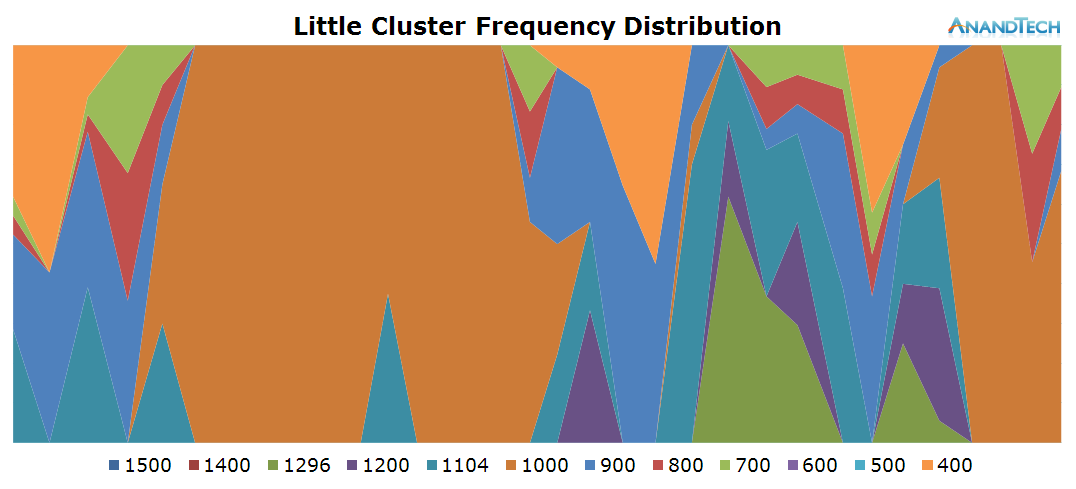

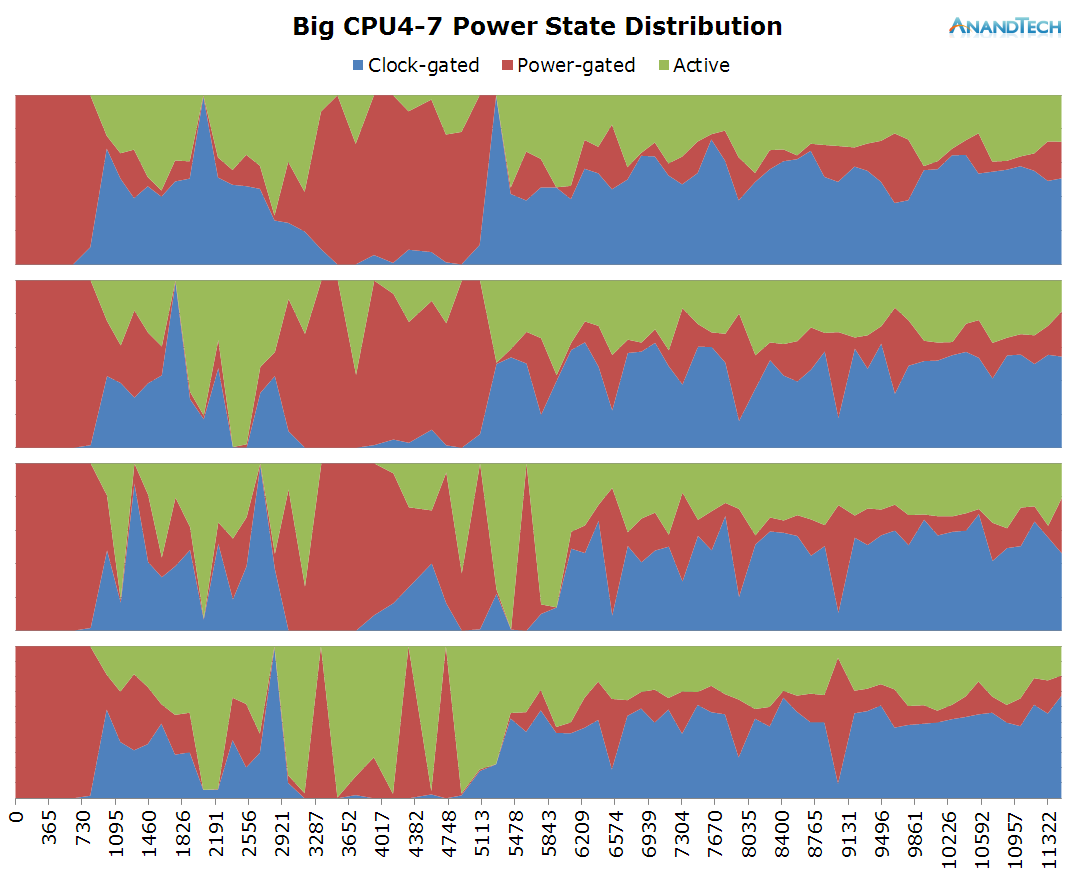
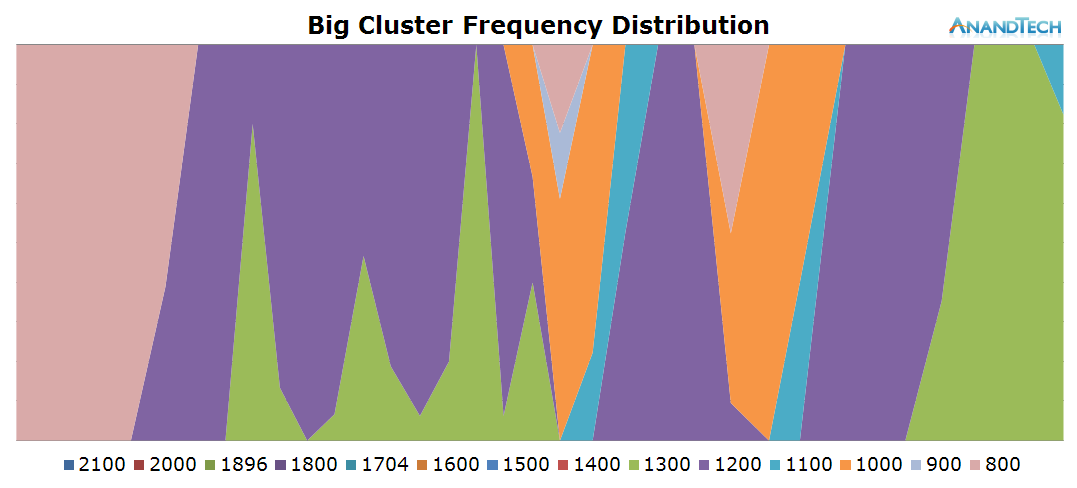
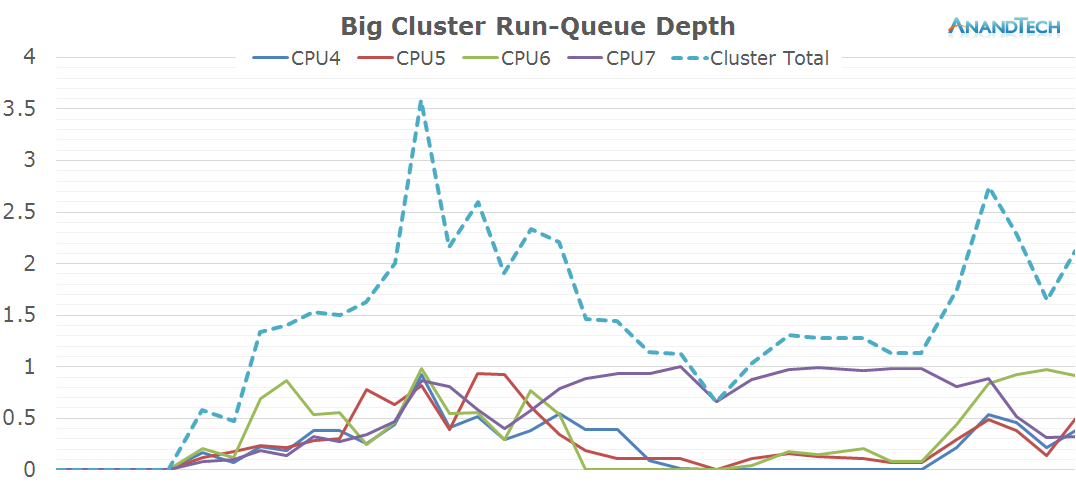
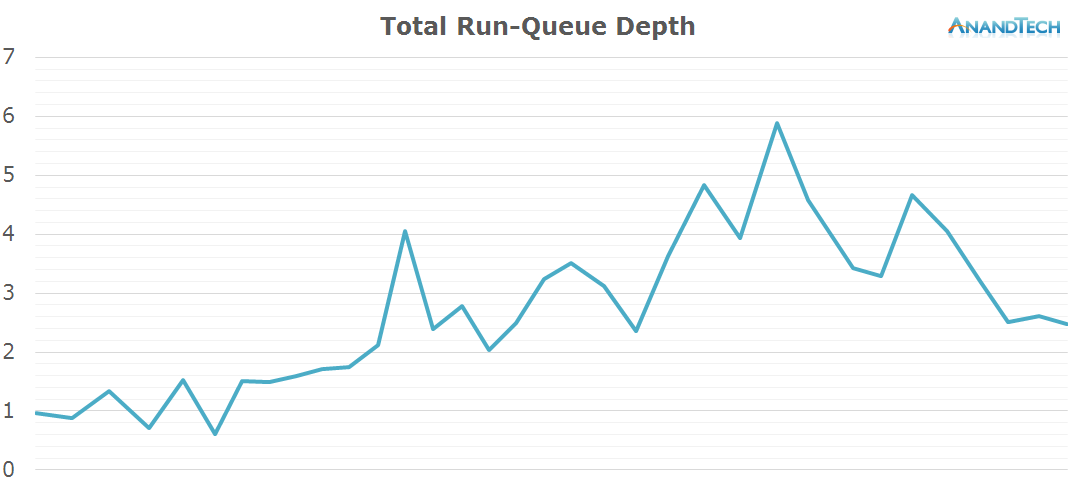








157 Comments
View All Comments
lilmoe - Tuesday, September 1, 2015 - link
"we're seeing what or how windows & the x86 platform has stagnated"Your argument is highly inaccurate and extremely dated. This isn't Windows XP era anymore... Windows 10 and 10 Mobile might as well be better than Android in what you're giving kudos to Google for (which they've somewhat managed after YEARS of promises). There's still a huge chunk of overhead in Android's rendering pipeline that needs serious attention. Android has made huge improvements, yes, but there still lots of work that needs to be done.
@Impulses has a good point too; It's extremely difficult to get a fair apples-to-apples comparison when it comes to optimal handling of workloads for varying thermal limits. CPUs at ~2W TDP behave VERY differently from those at 15W, and both behave yet differently from those running at 37W+. This becomes evident when middle ground ~5W mobile CPUs are in the picture, like Intel's Core M, where devices running those are showing no better battery life than their 15W counterparts running the same OS. (Windows 10 is changing that, however, and is showing extreme battery savings in these lower TDPs, more so than the improvements in higher TDP parts, which tells a lot about W10).
If that isn't clear enough already, read the article again. The author CLEARLY mentions in the first page not to make the mistake of applying the aforementioned metrics to other platforms and operating systems, and to strictly stick with Android and big.LITTLE.
Alexvrb - Tuesday, September 1, 2015 - link
Thank you lilmoe and name99! I read his comment and I was like really? These results don't support his claims and were never intended to compare platforms - as specifically stated by the author.R0H1T - Thursday, September 3, 2015 - link
XP to win10 took what a decade & a half? Vista was the last major change, after XP, DX10 & UAC, with win7 then win8 & now win10 bringing only incremental updates. Yeah I call that slow & we've had quad cores since what nearly a decade now, even then a vast majority of systems (desktops+notebooks) are dual core or 2 cores+HT surely that must make you cringe! Then we have programs that don't make use of multiple cores efficiently &/or the latest instruction sets like AVX. There's just a single web browser, that I know of, which uses the latter on PC! Call it whatever you may or twist it however you like to but this is one of the major reasons that PC sales are declining not just "everyone owns one & so they don't need it" excuse that's thrown around far too often. So far as "extrapolating this article to my observations" argument is concerned, there's no need to do that since there's historical precedence & copious amount of evidence to support pretty much every word of what I've said.Azethoth - Thursday, September 3, 2015 - link
Ugh dude, you have no idea what you are talking about. 4.4 architectures on a phone are a desperate attempt to reduce power usage. I am a programmer and compile times matter to me and threading helps. Even so going from 8 threads on my desktop CPU to 12 threads on the E CPU a year later only reduces a total recompile of 26 minutes by 2-3 minutes. But that E cannot clock as high, so in the regular incremental compile case it is slower. Do you get this? You are factually wrong for an actual core dependent use case.Now I can stick my head in the sand like you and pretend that more cores are automatically better but it just isn't for my workload. You may as well bitch that I should be running on multi thousand dollar server CPUs with 16 cores. Again no. They have their place in a server, but no place in my desktop.
Samus - Tuesday, September 1, 2015 - link
If "Google and Android" have 'nailed' MT then why do $600+ Android phones feel more sluggish, have a choppier UI, and launch programs slower than a 3 year old iPhone 5 or Lumia 800?Perhaps because the kernel and underlying architecture are so bloated because they need to support so many SOC's. They've resorted to heavy compression just to keep distribution sizes down, which also hits performance.
Android only has one place, on cheap phones. You're an idiot if you buy a $600+ Android phone when you get the same crappy experience on a $50 Kyocera.
I've tried so hard to like Android over the years, but every device I've had completely disappointed me compared to older Blackberry and modern iPhone devices where you don't need to find hacked distributions when manufactures drop the ball supporting the phone, or just make a crappy ROM in general. Even Nexus devices aren't immune to this and historically they haven't been very good phones, although admittedly, the only high-end Android phone worth buying is a Nexus, but now they cost so much it isn't justifiable.
Basically I recommend two phones to people. If they want a cheap phone, get a OnePlus One or some other sub-$300 Android device. If you're budget is higher, get an iPhone, or if you are adventurous, a WinMo device. At least the iPhone will receive support for 4-5 years and holds its value during that time.
Buk Lau - Tuesday, September 1, 2015 - link
I'm calling BS on most of your claims. Your experience with a Moto E (not saying it's a bad phone) will be vastly different from that of a Note 5, and those differences can start as obvious as how often you need to refresh your Chrome pages as you run out of RAM.What "600+" Android phone are you talking about that feels “more sluggish and slower” than a 3 year old iPhone? If you want people to take your claim seriously then at least provide some examples rather than this generic BS that anyone can easily come up with.
The way Android is designed makes it kind of difficult to bring updates as surprising as you may found. Every time the OS updates, there are changes to the HAL (hardware abstraction layer) and those changes can be minor or significant. It is then up to the SoC provider to provide the proper drivers needed after the HAL change, and they certainly won’t provide it for free. At the same time, OEM also have to decide how much the new update will impede performance. For example my first gen Moto X got an update to 5.1.1 a few months ago and despite the new features, there are still performance hits in places. Even older devices probably will do better on Jelly Bean and KitKat anyways since Google Play services can be updated independent of OS version.
Here’s some useful info on why Android is as fragmented as it is
http://www.xda-developers.com/opinion-android-is-i...
The biggest reason Apple updated all those 4S isn’t because how they loved their users, but rather to purposely slow down their devices to force them to upgrade. You can just ask the 4S users around you to see what iOS 8 really meant for them.
I do agree however that people should try more $300-400 devices that are near flagship level with compromises that are more tolerable, and this $600+ smartphone price should really tone itself down a bit.
Kutark - Tuesday, September 1, 2015 - link
Yeah i have to call bullshit on his claims too. I mean i know its anecdotal, but my buddies and i have had literally dozens of android phones over the years, as well as various iphones. And none of us have seen any kind of performance difference between the two. Im thinking he just had a shit experience with one android phone and like most people just wrote it off at that point.I have had a bad experience with an HTC Rezound, but every phone ive had before or after that has been fantastic. I absolutely LOVE my LG G3, its extremely responsive and fast, and i've never had issues with slowdowns on it. That being said i dont do any "gaming" (and i put gaming in quotes for a reason) on the phone, so i can't speak to that. But as far as browser, youtube, other apps, etc. It couldn't be more perfect.
Samus - Wednesday, September 2, 2015 - link
I'm at IT director and I have a "shit experience" with android phones people bring to me every week.Defending android is like defending your Kia Rio. It's a low cost tool to fit a low cost niche. The experience is the same no matter who is driving.
Kutark - Wednesday, September 2, 2015 - link
If you say so. As an IT director you should know that 99% of the time there is a problem, its user related and not hardware related. One thing i will give apple is that they lock their products down so hard that its much harder for the user to F it up. Whereas on more open platforms like android or windows, the user has much more control and thus much more ability to F things up royally.Whether thats a plus or a minus really just depends on what you're looking for. For people who want or need control over their hardware, its a plus, for people who just want something "to work" so to speak, its a minus.
mkozakewich - Wednesday, September 2, 2015 - link
Your claim that Apple is trying to slow down devices throws off your entire argument, really.